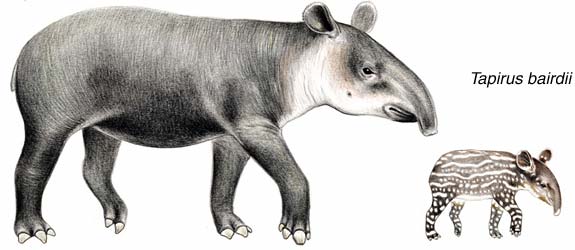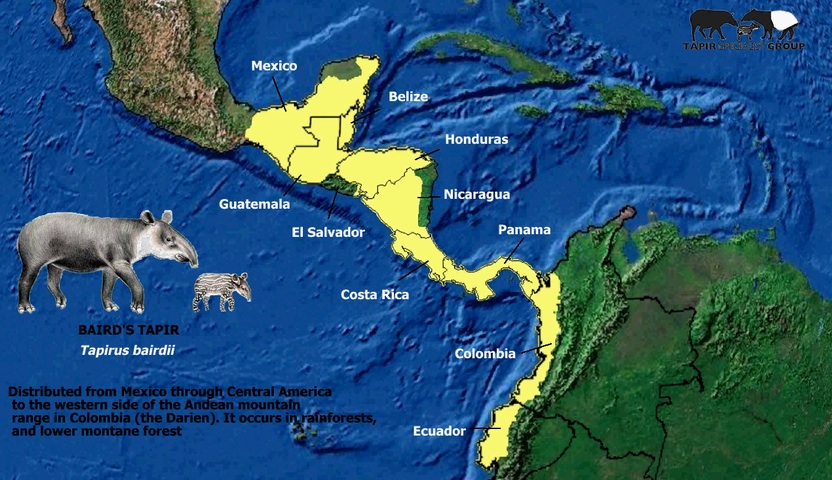The Baird’s Tapir
Tapirus bairdii
Status: Endangered

Also Known As
Danta (Spanish), mountain cow (Belize), macho del monte (Colombia & Costa Rica).

Illustration generously provided by Stephen Nash, Conservation International
Characteristics
The baird’s tapir is smaller than the lowland tapir, can grow up to 1.5 meters long (5 feet) and 250 kg (550 pounds). It lacks the mane or crest indicative of the lowland tapir, but has a similar brown short coat. It has a thick tough hide, particularly on its hindquarters.
Habitat and Range
The Baird’s tapir is found in Oaxaca Province in Mexico through parts of Central America, including the western side of the Andean mountain range in Colombia (the Darien).
Baird’s tapirs live in rainforests, lower montane forests, deciduous forests, flooded grasslands and marsh areas.
Baird’s Tapir Range Map

May by Carlos Pedraza, Tapir Specialist Group, 2008
Threats to Their Survival
The major threats to the species are habitat destruction and fragmentation and hunting throughout its range. Deaths have been recorded through collisions with automobiles, particularly in Belize.
Population Estimate (2006): Estimates suggest that there are less than 5,500 Baird’s tapir remaining in the wild, with populations in Mexico under 1,500, Guatemala under 1,000, Honduras under 500, Nicaragua under 500, Republic of Panama under 1,000, Costa Rica under 1000, and Colombia approximately 250. Populations of Baird’s tapir are in a continuing decline.
Other Baird’s Tapir Facts
Primarily solitary, the species forms occasional associations with others and for breeding. There is no evidence of one tapir claiming an exclusive territory. Males appear to have small home ranges (about 1 sq km) and females range much more widely.
Communication is by a range of whistles of different pitch and duration. The baird’s tapir whistles to communicate with its young and to announce its territory to rivals.
Baird’s tapirs are most active at dusk and throughout the night, retiring to shelter of thick vegetation in the early morning. They are occasionally seen during the day seeking water to drink and cool down in.
The scoop on poop: Baird’s tapirs often defecate in water as well as on land and at “dump sites.” These sites and the spraying of urine onto vegetation and trees are thought to be associated with home range marking.
Baird’s tapirs eat the twigs and growing tips of a wide range of understory vegetation, and they snap small saplings with their mouths to get to tall plants. They also eat a wide variety of fruits and leaves from the forest floor as well as aquatic vegetation.
Baird’s tapirs are one of the many food sources for jaguars and pumas.
Scientific Sources:
BROOKS, D.; BODMER, R.E.; MATOLA, S (compilers). 1997. Tapirs – Status Survey and Conservation Action Plan. (English, Spanish, Portuguese.) IUCN/SSC Tapir Specialist Group. IUCN, Gland, Switzerland and Cambridge,UK.viii+164pp. Dirección en la Red. http://www.tapirback.com/tapirgal/iucn-ssc/tsg/action97/cover.htm
EMMONS, L. 1990. Neotropical Rainforest Mammals. The University of Chicago Press. USA. 281p
FOERSTER, C. 1998. Uso de hábitat, ámbito de hogar y actividad de la danta centroamericana en un bosque tropical húmedo de C.R. Tesis de Posgrado, Programa Regional de Manejo de Vida Silvestre para Mesoamerica y el Caribe.
FOERSTER, C. 1998. Comportamiento de forrajeo y dieta de una danta centroamericana en un bosque tropical húmedo de C.R. Tesis de Posgrado, Programa Regional de Manejo de Vida Silvestre para Mesoamerica y el Caribe.
FRAGOSO, J. 1983. The ecology and behavior of Baird’s tapir in Belize. Documento del centro de Documentación de la universidad de Heredia, Costa Rica.
FRAGOSO, J. 1987. The habitat preferences and social structure of tapirs. Masters Thesis, University of Toronto, Ontario, Canada.
GAMERO, I. 1978. Mamíferos de mi tierra. López y Cia, Tegucigalpa, Honduras.
GARCÍA, M. 2006. Caracterización de la dieta y el hábitat del tapir (Tapirus bairdii Gill, 1865) en ecosistemas ribereños del Parque Nacional Laguna Lachuá, Cobán, Alta Verapaz, Guatemala. Tesis para optar al título de Licenciado en Biología Universidad de San Carlos de Guatemala.
IUCN 2006. Red List IUCN. www.uicnredlist.org
JANZEN, D. 1981. Artículo Digestive seed predation by a Costa Rican Baird’s Tapir. Reproductive Botany Journal, 59-63.
LIRA T. I., NARANJO P., E. y REYES Ch., 2005. Ampliación del área de distribución de Tapirus bairdii, Gill 1865 (Perissodactyla: Tapiridae) en Oaxaca, México. Acta Zoológica Mexicana (n.s.) 21(1): 107-110
MARCH, I. 1994. Situación actual del tapir en México. Serie Monográfica No.1. Centro de Investigaciones Ecológicas del Sureste. Chiapas, México.
NARANJO, E. 1994. Abundancia y uso de hábitat del Tapir (Tapirus bairdii) en un bosque tropical húmedo de C.R. Programa Regional en Manejo de Vida Silvestre.
2006. Third International Tapir Symposium. Conference Report. Electronic version available at www.tapirs.org
REID, F. 1997. A field Guide to the Mammals of central America and southeast México. Oxford University Press. USA. 334p.
SCHLESINGER, V. 1999. Animals and plants of the ancient maya. University of Texas Press. USA. (pg 151-153).
TOBLER, M.W. 2002. Uso del hábitat y dieta de la danta centroamericana (Tapirus bairdii) en un bosque nuboso montano de la Cordillera de Talamanca, Costa Rica. Biotropica. v. 34, no. 3. p. 468-474.
WILLIAMS, K. 1984. The Central American Tapir (Tapirus bairdii) in northwest C.R. Ph.D Thesis, Michigan State University, Department of fisheries and wildlife.
Written with the help of Keith Williams and Manolo Garcia, Tapir Specialist Group members.
